Environmental Risks and Maritime Logistics in Australia: A Report
VerifiedAdded on 2023/04/03
|113
|21640
|176
Report
AI Summary
This research report evaluates the environmental risks associated with maritime logistics, focusing on the Australian context. It examines the impact of globalization on the shipping industry, highlighting the importance of efficient product transmission across countries. The report delves into the definition and activities of maritime logistics, different types of cargo, and the environmental risks linked to the industry, including risks specific to Australia. A literature review and various research methods, including data analysis and content analysis, are used to analyze the environmental issues and threats. The study concludes with recommendations for risk management, suggesting that companies focus on environmental risks and develop risk management plans to monitor and mitigate these problems. The report underscores the need for sustainable practices and risk mitigation strategies in the maritime logistics sector to minimize environmental impact. The report also includes a detailed methodology section, presenting the research design, data collection methods, and analysis techniques used to investigate the environmental impacts and potential solutions within the maritime logistics sector.
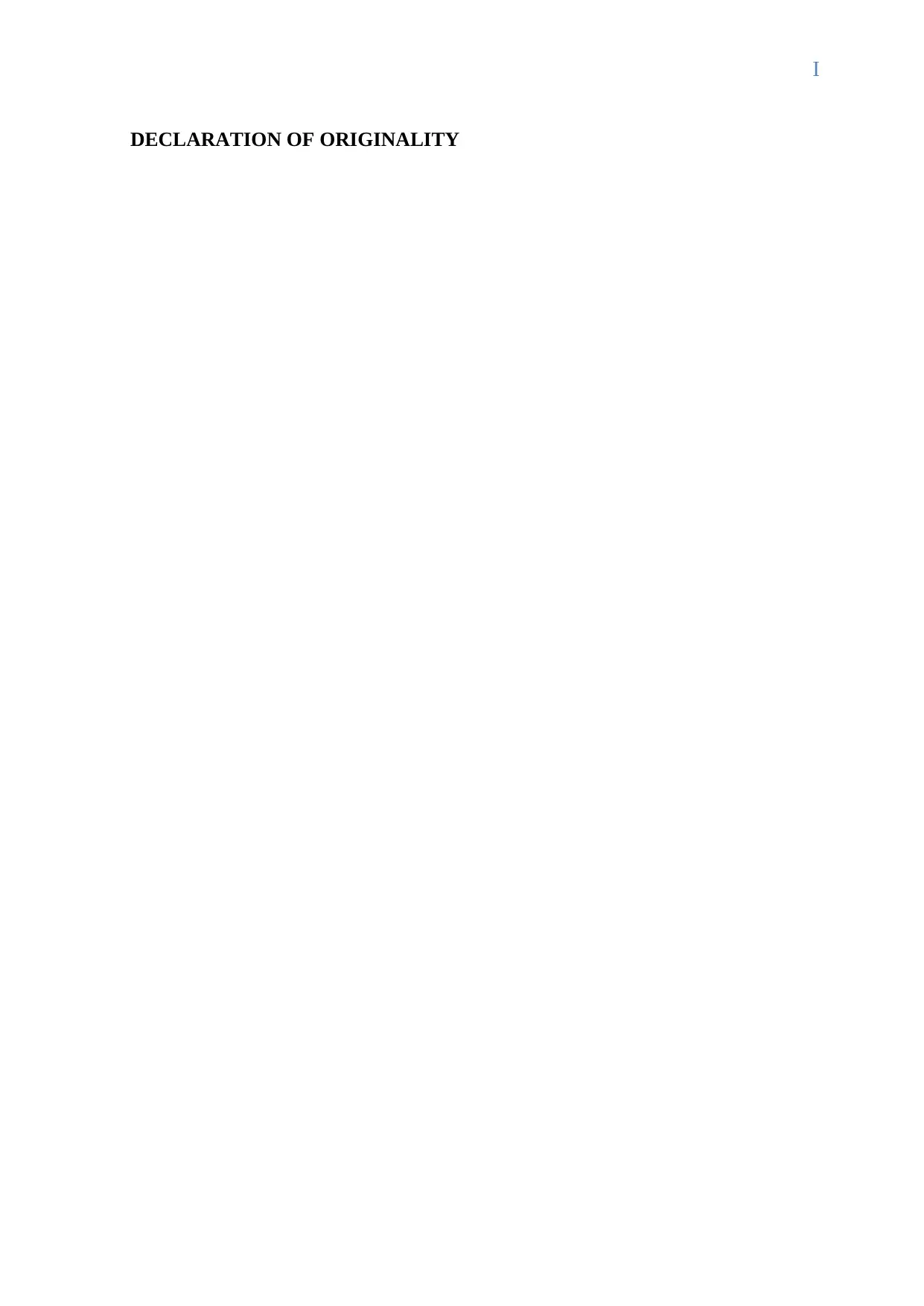
I
DECLARATION OF ORIGINALITY
DECLARATION OF ORIGINALITY
Paraphrase This Document
Need a fresh take? Get an instant paraphrase of this document with our AI Paraphraser

II
STATEMENT OF ETHICAL CONDUCT
STATEMENT OF ETHICAL CONDUCT

III
ACKNOWLEDGEMENT
ACKNOWLEDGEMENT
⊘ This is a preview!⊘
Do you want full access?
Subscribe today to unlock all pages.

Trusted by 1+ million students worldwide
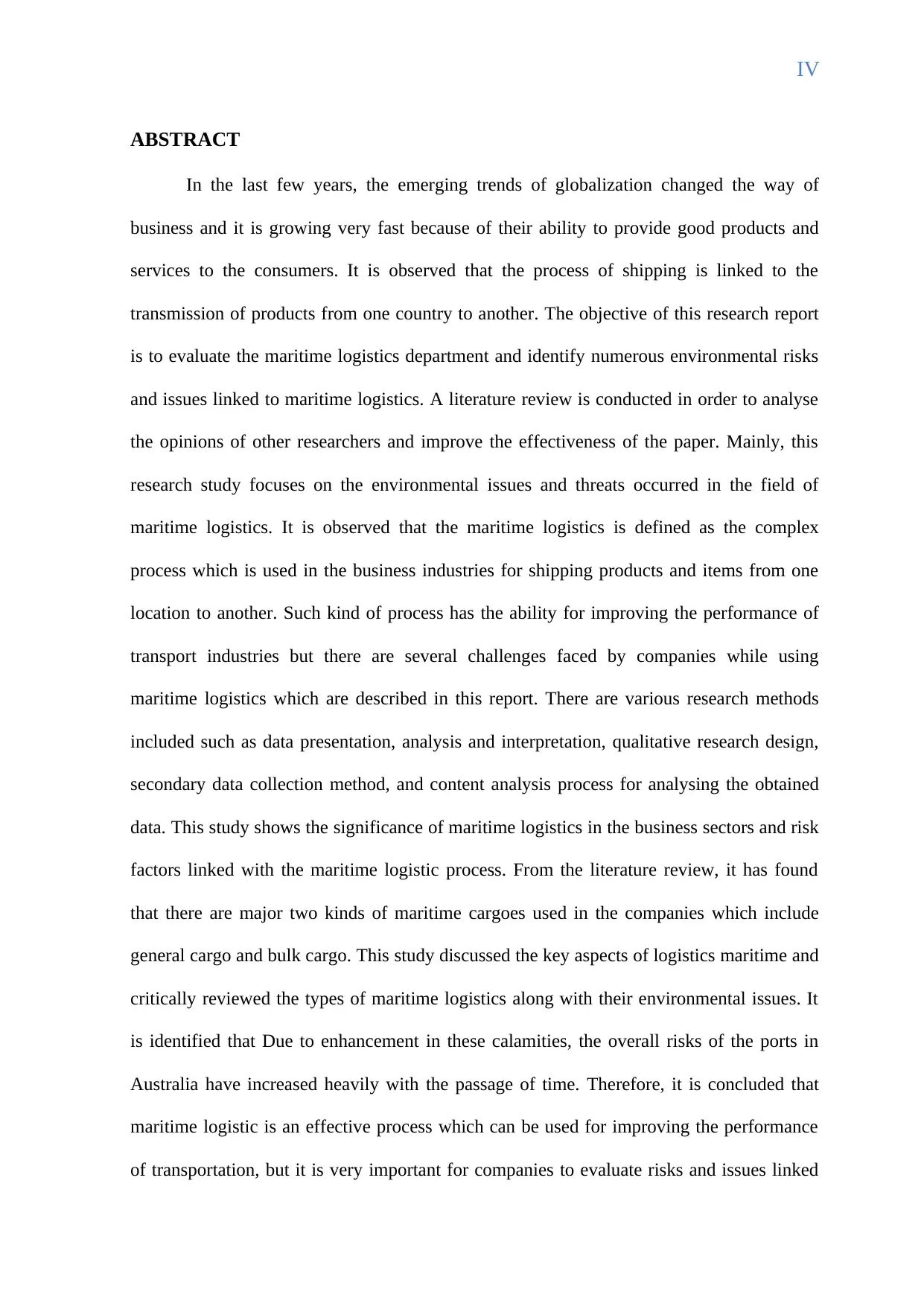
IV
ABSTRACT
In the last few years, the emerging trends of globalization changed the way of
business and it is growing very fast because of their ability to provide good products and
services to the consumers. It is observed that the process of shipping is linked to the
transmission of products from one country to another. The objective of this research report
is to evaluate the maritime logistics department and identify numerous environmental risks
and issues linked to maritime logistics. A literature review is conducted in order to analyse
the opinions of other researchers and improve the effectiveness of the paper. Mainly, this
research study focuses on the environmental issues and threats occurred in the field of
maritime logistics. It is observed that the maritime logistics is defined as the complex
process which is used in the business industries for shipping products and items from one
location to another. Such kind of process has the ability for improving the performance of
transport industries but there are several challenges faced by companies while using
maritime logistics which are described in this report. There are various research methods
included such as data presentation, analysis and interpretation, qualitative research design,
secondary data collection method, and content analysis process for analysing the obtained
data. This study shows the significance of maritime logistics in the business sectors and risk
factors linked with the maritime logistic process. From the literature review, it has found
that there are major two kinds of maritime cargoes used in the companies which include
general cargo and bulk cargo. This study discussed the key aspects of logistics maritime and
critically reviewed the types of maritime logistics along with their environmental issues. It
is identified that Due to enhancement in these calamities, the overall risks of the ports in
Australia have increased heavily with the passage of time. Therefore, it is concluded that
maritime logistic is an effective process which can be used for improving the performance
of transportation, but it is very important for companies to evaluate risks and issues linked
ABSTRACT
In the last few years, the emerging trends of globalization changed the way of
business and it is growing very fast because of their ability to provide good products and
services to the consumers. It is observed that the process of shipping is linked to the
transmission of products from one country to another. The objective of this research report
is to evaluate the maritime logistics department and identify numerous environmental risks
and issues linked to maritime logistics. A literature review is conducted in order to analyse
the opinions of other researchers and improve the effectiveness of the paper. Mainly, this
research study focuses on the environmental issues and threats occurred in the field of
maritime logistics. It is observed that the maritime logistics is defined as the complex
process which is used in the business industries for shipping products and items from one
location to another. Such kind of process has the ability for improving the performance of
transport industries but there are several challenges faced by companies while using
maritime logistics which are described in this report. There are various research methods
included such as data presentation, analysis and interpretation, qualitative research design,
secondary data collection method, and content analysis process for analysing the obtained
data. This study shows the significance of maritime logistics in the business sectors and risk
factors linked with the maritime logistic process. From the literature review, it has found
that there are major two kinds of maritime cargoes used in the companies which include
general cargo and bulk cargo. This study discussed the key aspects of logistics maritime and
critically reviewed the types of maritime logistics along with their environmental issues. It
is identified that Due to enhancement in these calamities, the overall risks of the ports in
Australia have increased heavily with the passage of time. Therefore, it is concluded that
maritime logistic is an effective process which can be used for improving the performance
of transportation, but it is very important for companies to evaluate risks and issues linked
Paraphrase This Document
Need a fresh take? Get an instant paraphrase of this document with our AI Paraphraser
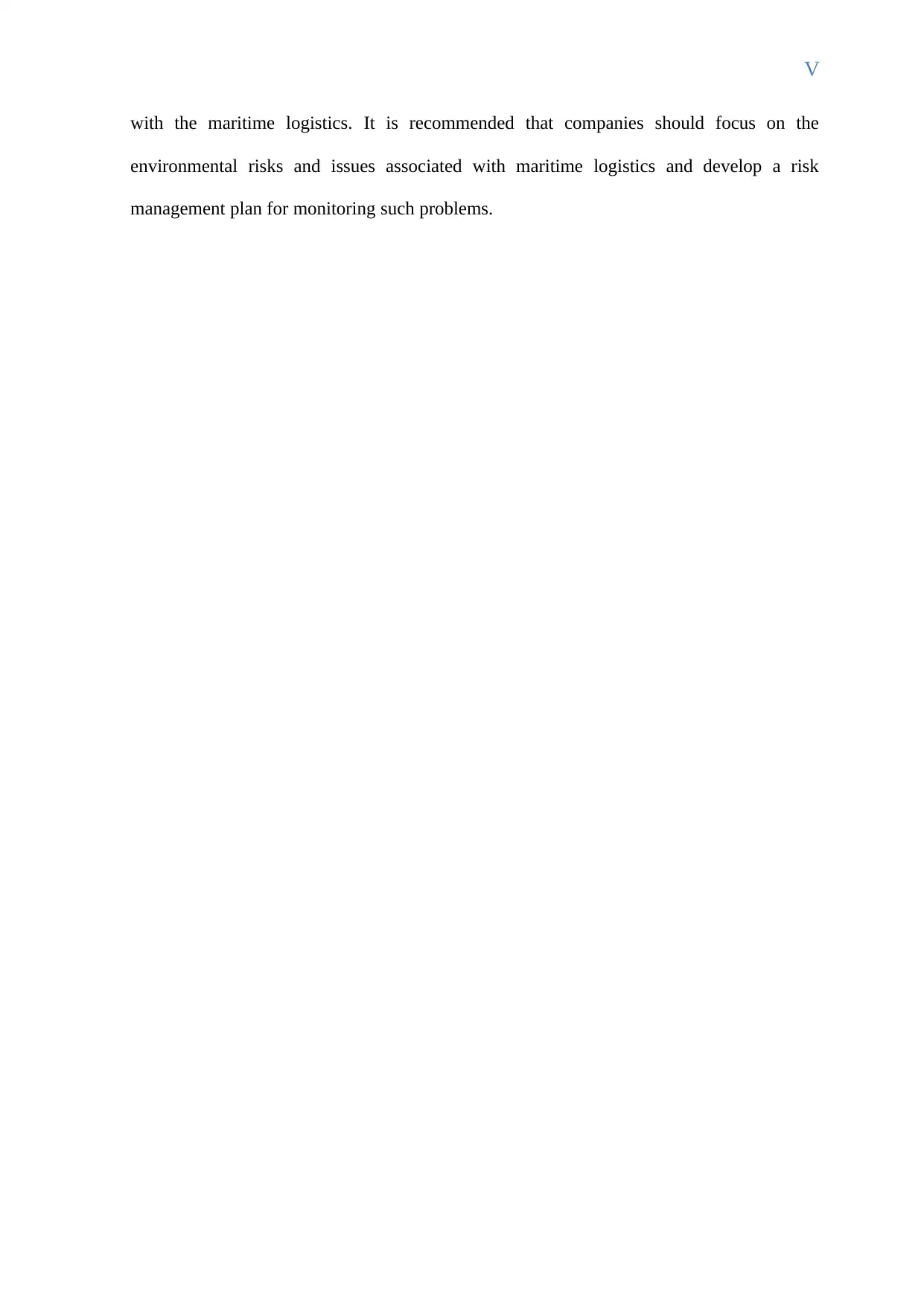
V
with the maritime logistics. It is recommended that companies should focus on the
environmental risks and issues associated with maritime logistics and develop a risk
management plan for monitoring such problems.
with the maritime logistics. It is recommended that companies should focus on the
environmental risks and issues associated with maritime logistics and develop a risk
management plan for monitoring such problems.
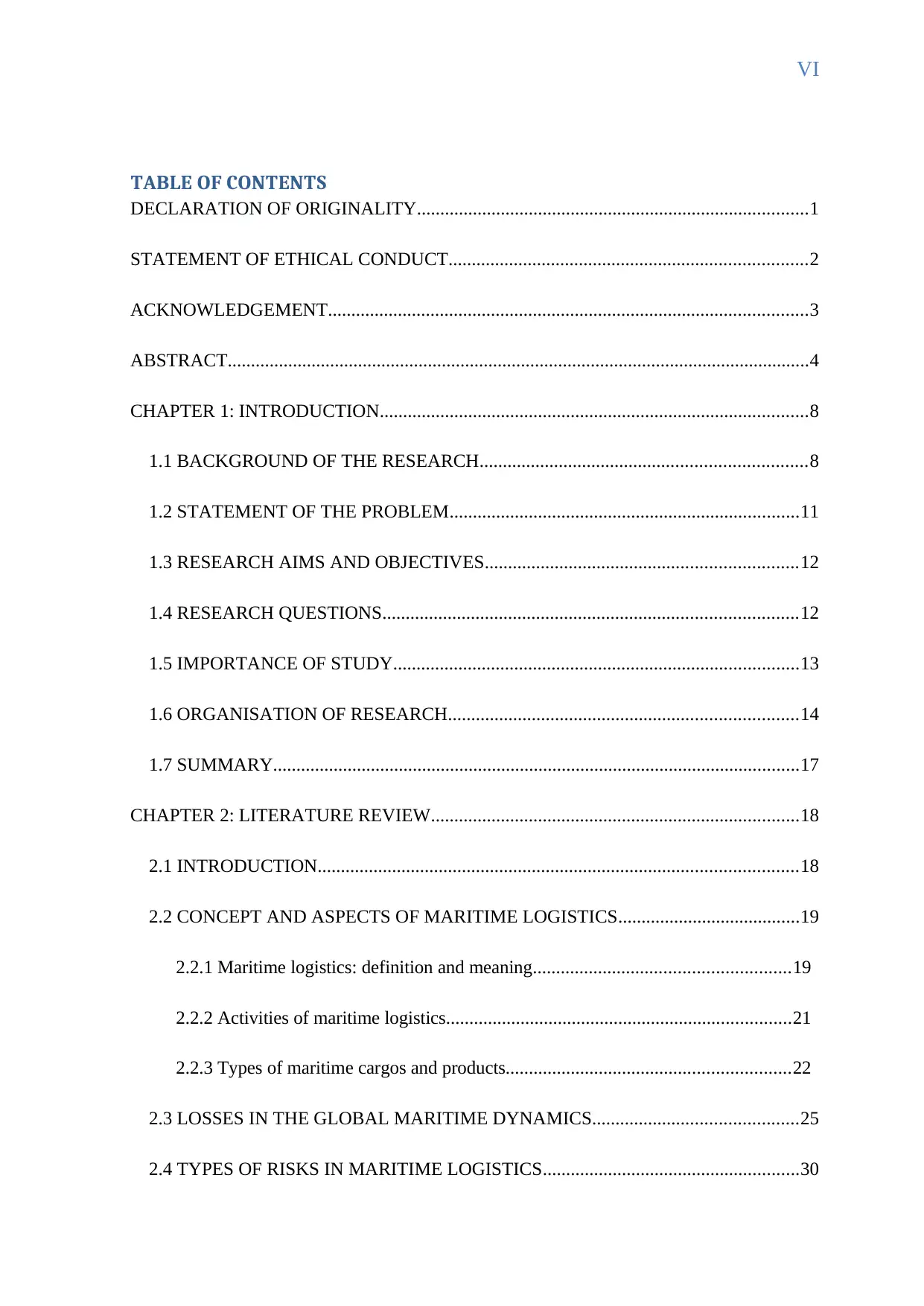
VI
TABLE OF CONTENTS
DECLARATION OF ORIGINALITY....................................................................................1
STATEMENT OF ETHICAL CONDUCT.............................................................................2
ACKNOWLEDGEMENT.......................................................................................................3
ABSTRACT.............................................................................................................................4
CHAPTER 1: INTRODUCTION............................................................................................8
1.1 BACKGROUND OF THE RESEARCH......................................................................8
1.2 STATEMENT OF THE PROBLEM...........................................................................11
1.3 RESEARCH AIMS AND OBJECTIVES...................................................................12
1.4 RESEARCH QUESTIONS.........................................................................................12
1.5 IMPORTANCE OF STUDY.......................................................................................13
1.6 ORGANISATION OF RESEARCH...........................................................................14
1.7 SUMMARY.................................................................................................................17
CHAPTER 2: LITERATURE REVIEW...............................................................................18
2.1 INTRODUCTION.......................................................................................................18
2.2 CONCEPT AND ASPECTS OF MARITIME LOGISTICS.......................................19
2.2.1 Maritime logistics: definition and meaning.......................................................19
2.2.2 Activities of maritime logistics..........................................................................21
2.2.3 Types of maritime cargos and products.............................................................22
2.3 LOSSES IN THE GLOBAL MARITIME DYNAMICS............................................25
2.4 TYPES OF RISKS IN MARITIME LOGISTICS.......................................................30
TABLE OF CONTENTS
DECLARATION OF ORIGINALITY....................................................................................1
STATEMENT OF ETHICAL CONDUCT.............................................................................2
ACKNOWLEDGEMENT.......................................................................................................3
ABSTRACT.............................................................................................................................4
CHAPTER 1: INTRODUCTION............................................................................................8
1.1 BACKGROUND OF THE RESEARCH......................................................................8
1.2 STATEMENT OF THE PROBLEM...........................................................................11
1.3 RESEARCH AIMS AND OBJECTIVES...................................................................12
1.4 RESEARCH QUESTIONS.........................................................................................12
1.5 IMPORTANCE OF STUDY.......................................................................................13
1.6 ORGANISATION OF RESEARCH...........................................................................14
1.7 SUMMARY.................................................................................................................17
CHAPTER 2: LITERATURE REVIEW...............................................................................18
2.1 INTRODUCTION.......................................................................................................18
2.2 CONCEPT AND ASPECTS OF MARITIME LOGISTICS.......................................19
2.2.1 Maritime logistics: definition and meaning.......................................................19
2.2.2 Activities of maritime logistics..........................................................................21
2.2.3 Types of maritime cargos and products.............................................................22
2.3 LOSSES IN THE GLOBAL MARITIME DYNAMICS............................................25
2.4 TYPES OF RISKS IN MARITIME LOGISTICS.......................................................30
⊘ This is a preview!⊘
Do you want full access?
Subscribe today to unlock all pages.

Trusted by 1+ million students worldwide
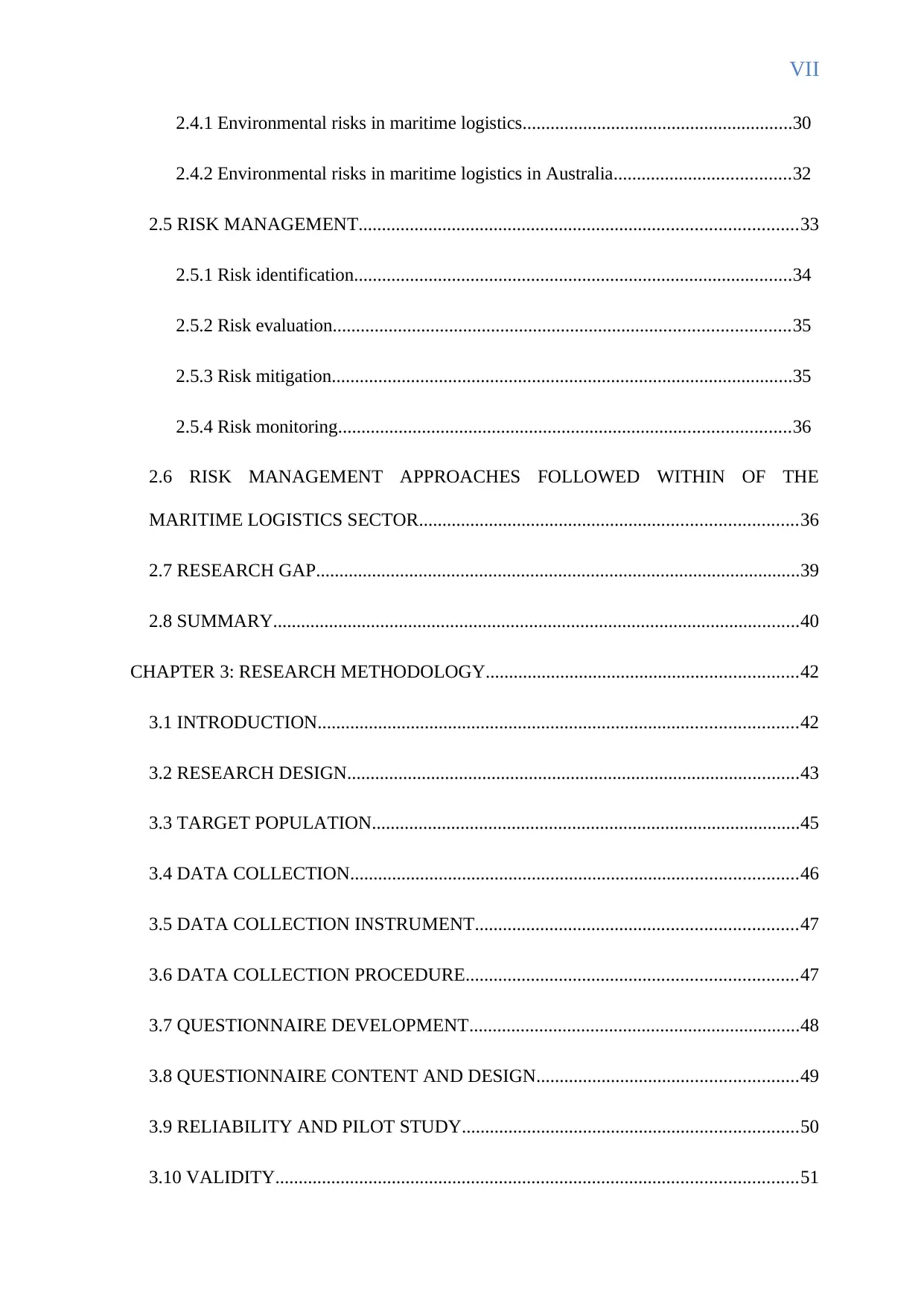
VII
2.4.1 Environmental risks in maritime logistics..........................................................30
2.4.2 Environmental risks in maritime logistics in Australia......................................32
2.5 RISK MANAGEMENT..............................................................................................33
2.5.1 Risk identification..............................................................................................34
2.5.2 Risk evaluation..................................................................................................35
2.5.3 Risk mitigation...................................................................................................35
2.5.4 Risk monitoring.................................................................................................36
2.6 RISK MANAGEMENT APPROACHES FOLLOWED WITHIN OF THE
MARITIME LOGISTICS SECTOR.................................................................................36
2.7 RESEARCH GAP........................................................................................................39
2.8 SUMMARY.................................................................................................................40
CHAPTER 3: RESEARCH METHODOLOGY...................................................................42
3.1 INTRODUCTION.......................................................................................................42
3.2 RESEARCH DESIGN.................................................................................................43
3.3 TARGET POPULATION............................................................................................45
3.4 DATA COLLECTION................................................................................................46
3.5 DATA COLLECTION INSTRUMENT.....................................................................47
3.6 DATA COLLECTION PROCEDURE.......................................................................47
3.7 QUESTIONNAIRE DEVELOPMENT.......................................................................48
3.8 QUESTIONNAIRE CONTENT AND DESIGN........................................................49
3.9 RELIABILITY AND PILOT STUDY........................................................................50
3.10 VALIDITY................................................................................................................51
2.4.1 Environmental risks in maritime logistics..........................................................30
2.4.2 Environmental risks in maritime logistics in Australia......................................32
2.5 RISK MANAGEMENT..............................................................................................33
2.5.1 Risk identification..............................................................................................34
2.5.2 Risk evaluation..................................................................................................35
2.5.3 Risk mitigation...................................................................................................35
2.5.4 Risk monitoring.................................................................................................36
2.6 RISK MANAGEMENT APPROACHES FOLLOWED WITHIN OF THE
MARITIME LOGISTICS SECTOR.................................................................................36
2.7 RESEARCH GAP........................................................................................................39
2.8 SUMMARY.................................................................................................................40
CHAPTER 3: RESEARCH METHODOLOGY...................................................................42
3.1 INTRODUCTION.......................................................................................................42
3.2 RESEARCH DESIGN.................................................................................................43
3.3 TARGET POPULATION............................................................................................45
3.4 DATA COLLECTION................................................................................................46
3.5 DATA COLLECTION INSTRUMENT.....................................................................47
3.6 DATA COLLECTION PROCEDURE.......................................................................47
3.7 QUESTIONNAIRE DEVELOPMENT.......................................................................48
3.8 QUESTIONNAIRE CONTENT AND DESIGN........................................................49
3.9 RELIABILITY AND PILOT STUDY........................................................................50
3.10 VALIDITY................................................................................................................51
Paraphrase This Document
Need a fresh take? Get an instant paraphrase of this document with our AI Paraphraser
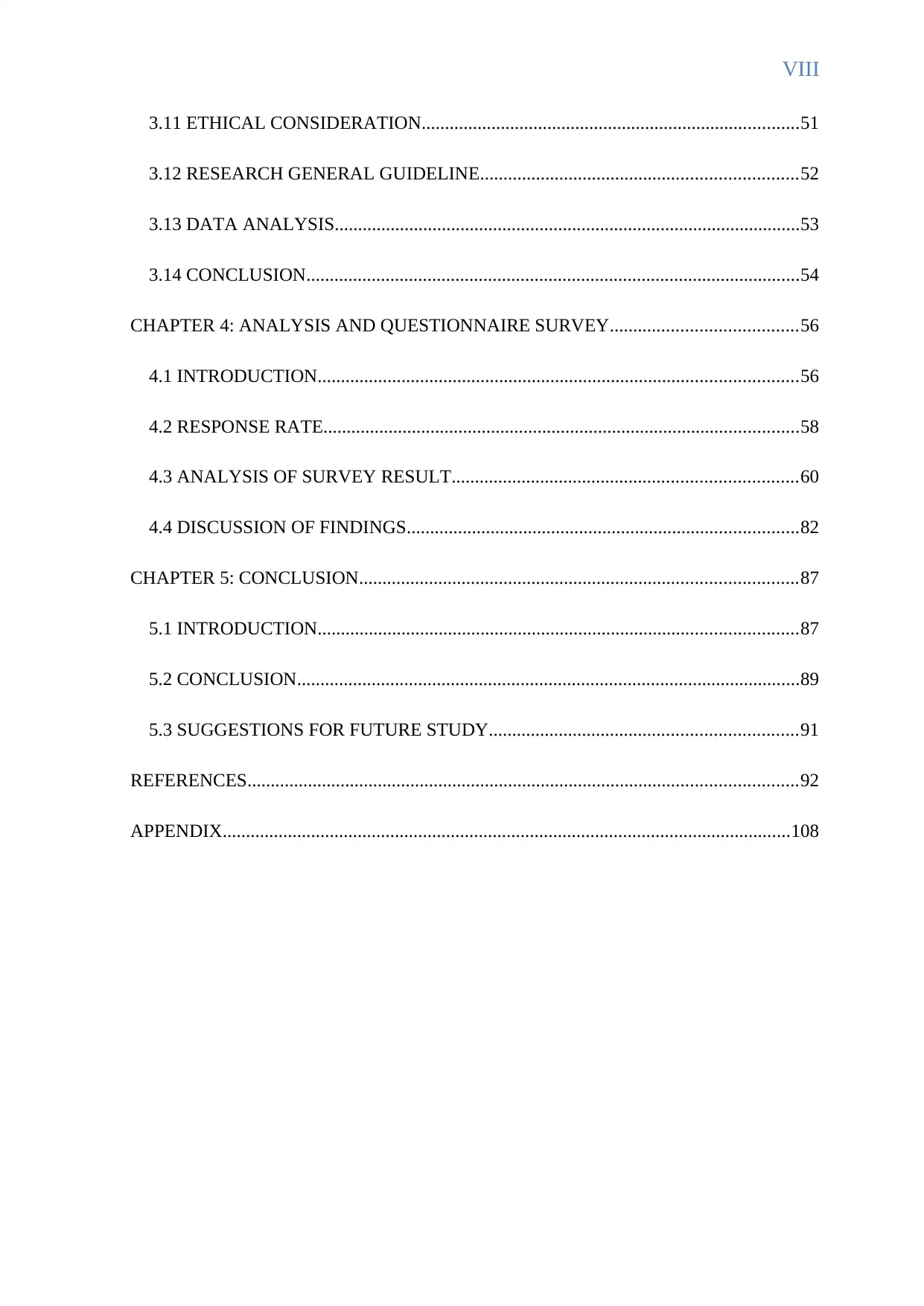
VIII
3.11 ETHICAL CONSIDERATION.................................................................................51
3.12 RESEARCH GENERAL GUIDELINE....................................................................52
3.13 DATA ANALYSIS....................................................................................................53
3.14 CONCLUSION..........................................................................................................54
CHAPTER 4: ANALYSIS AND QUESTIONNAIRE SURVEY........................................56
4.1 INTRODUCTION.......................................................................................................56
4.2 RESPONSE RATE......................................................................................................58
4.3 ANALYSIS OF SURVEY RESULT..........................................................................60
4.4 DISCUSSION OF FINDINGS....................................................................................82
CHAPTER 5: CONCLUSION..............................................................................................87
5.1 INTRODUCTION.......................................................................................................87
5.2 CONCLUSION............................................................................................................89
5.3 SUGGESTIONS FOR FUTURE STUDY..................................................................91
REFERENCES......................................................................................................................92
APPENDIX..........................................................................................................................108
3.11 ETHICAL CONSIDERATION.................................................................................51
3.12 RESEARCH GENERAL GUIDELINE....................................................................52
3.13 DATA ANALYSIS....................................................................................................53
3.14 CONCLUSION..........................................................................................................54
CHAPTER 4: ANALYSIS AND QUESTIONNAIRE SURVEY........................................56
4.1 INTRODUCTION.......................................................................................................56
4.2 RESPONSE RATE......................................................................................................58
4.3 ANALYSIS OF SURVEY RESULT..........................................................................60
4.4 DISCUSSION OF FINDINGS....................................................................................82
CHAPTER 5: CONCLUSION..............................................................................................87
5.1 INTRODUCTION.......................................................................................................87
5.2 CONCLUSION............................................................................................................89
5.3 SUGGESTIONS FOR FUTURE STUDY..................................................................91
REFERENCES......................................................................................................................92
APPENDIX..........................................................................................................................108
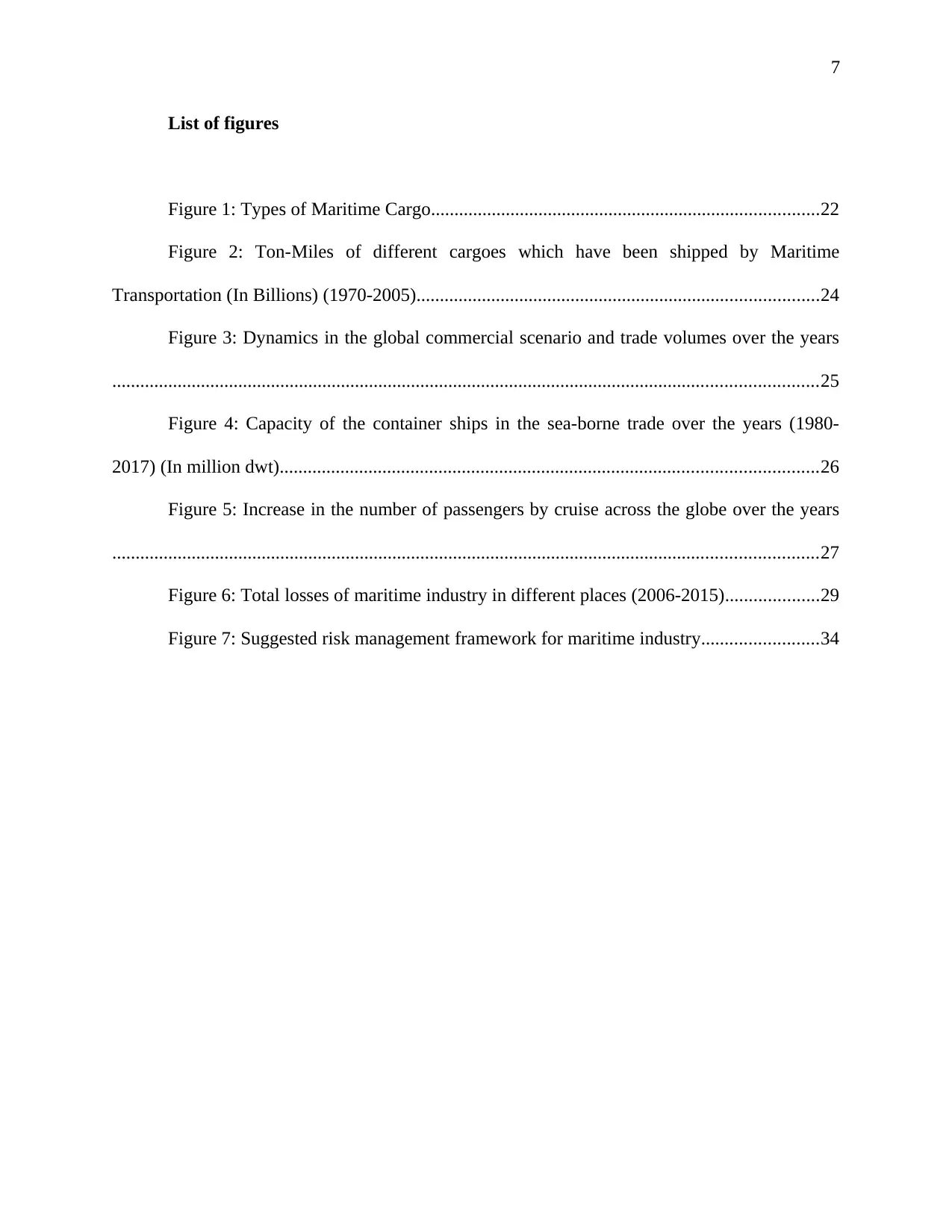
7
List of figures
Figure 1: Types of Maritime Cargo...................................................................................22
Figure 2: Ton-Miles of different cargoes which have been shipped by Maritime
Transportation (In Billions) (1970-2005)......................................................................................24
Figure 3: Dynamics in the global commercial scenario and trade volumes over the years
.......................................................................................................................................................25
Figure 4: Capacity of the container ships in the sea-borne trade over the years (1980-
2017) (In million dwt)...................................................................................................................26
Figure 5: Increase in the number of passengers by cruise across the globe over the years
.......................................................................................................................................................27
Figure 6: Total losses of maritime industry in different places (2006-2015)....................29
Figure 7: Suggested risk management framework for maritime industry.........................34
List of figures
Figure 1: Types of Maritime Cargo...................................................................................22
Figure 2: Ton-Miles of different cargoes which have been shipped by Maritime
Transportation (In Billions) (1970-2005)......................................................................................24
Figure 3: Dynamics in the global commercial scenario and trade volumes over the years
.......................................................................................................................................................25
Figure 4: Capacity of the container ships in the sea-borne trade over the years (1980-
2017) (In million dwt)...................................................................................................................26
Figure 5: Increase in the number of passengers by cruise across the globe over the years
.......................................................................................................................................................27
Figure 6: Total losses of maritime industry in different places (2006-2015)....................29
Figure 7: Suggested risk management framework for maritime industry.........................34
⊘ This is a preview!⊘
Do you want full access?
Subscribe today to unlock all pages.

Trusted by 1+ million students worldwide
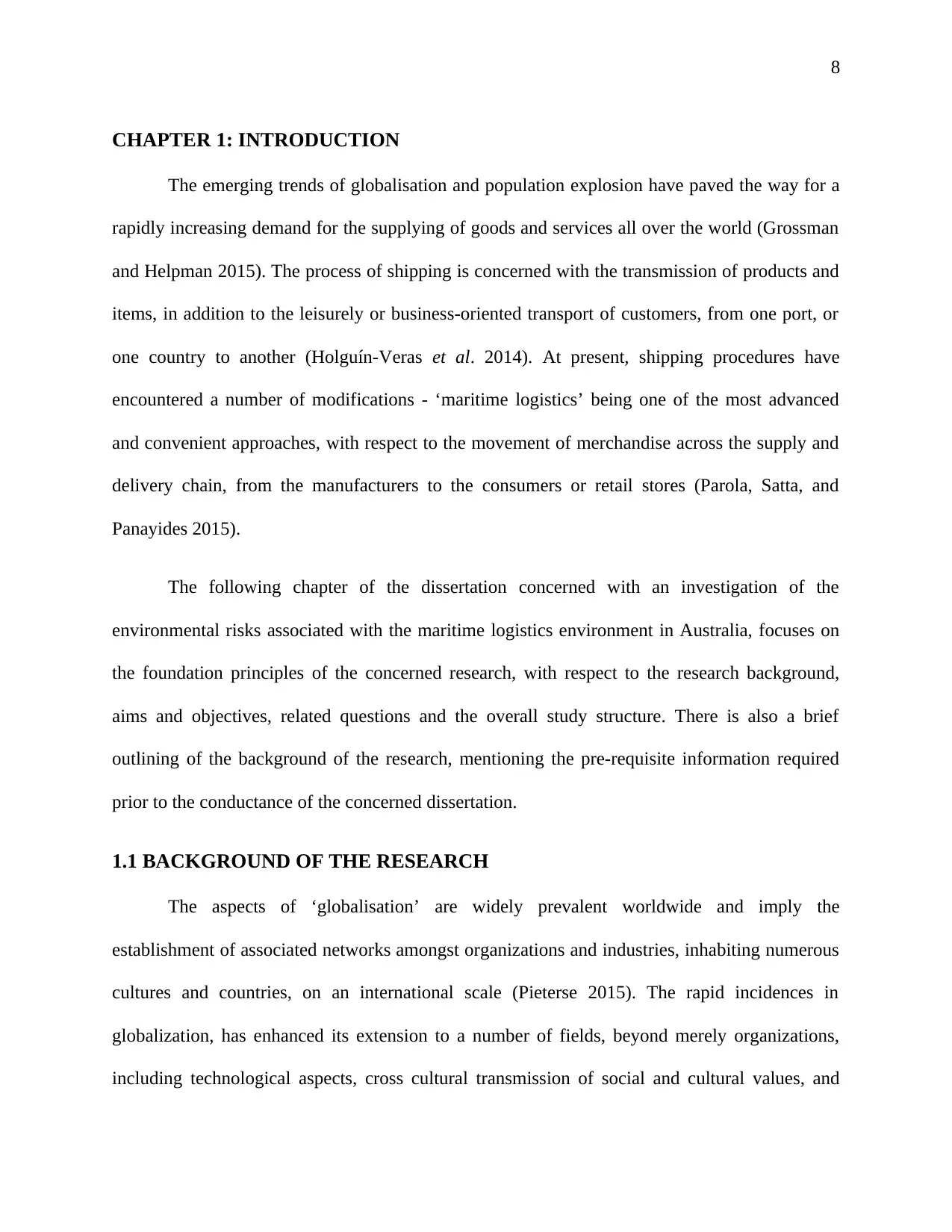
8
CHAPTER 1: INTRODUCTION
The emerging trends of globalisation and population explosion have paved the way for a
rapidly increasing demand for the supplying of goods and services all over the world (Grossman
and Helpman 2015). The process of shipping is concerned with the transmission of products and
items, in addition to the leisurely or business-oriented transport of customers, from one port, or
one country to another (Holguín-Veras et al. 2014). At present, shipping procedures have
encountered a number of modifications - ‘maritime logistics’ being one of the most advanced
and convenient approaches, with respect to the movement of merchandise across the supply and
delivery chain, from the manufacturers to the consumers or retail stores (Parola, Satta, and
Panayides 2015).
The following chapter of the dissertation concerned with an investigation of the
environmental risks associated with the maritime logistics environment in Australia, focuses on
the foundation principles of the concerned research, with respect to the research background,
aims and objectives, related questions and the overall study structure. There is also a brief
outlining of the background of the research, mentioning the pre-requisite information required
prior to the conductance of the concerned dissertation.
1.1 BACKGROUND OF THE RESEARCH
The aspects of ‘globalisation’ are widely prevalent worldwide and imply the
establishment of associated networks amongst organizations and industries, inhabiting numerous
cultures and countries, on an international scale (Pieterse 2015). The rapid incidences in
globalization, has enhanced its extension to a number of fields, beyond merely organizations,
including technological aspects, cross cultural transmission of social and cultural values, and
CHAPTER 1: INTRODUCTION
The emerging trends of globalisation and population explosion have paved the way for a
rapidly increasing demand for the supplying of goods and services all over the world (Grossman
and Helpman 2015). The process of shipping is concerned with the transmission of products and
items, in addition to the leisurely or business-oriented transport of customers, from one port, or
one country to another (Holguín-Veras et al. 2014). At present, shipping procedures have
encountered a number of modifications - ‘maritime logistics’ being one of the most advanced
and convenient approaches, with respect to the movement of merchandise across the supply and
delivery chain, from the manufacturers to the consumers or retail stores (Parola, Satta, and
Panayides 2015).
The following chapter of the dissertation concerned with an investigation of the
environmental risks associated with the maritime logistics environment in Australia, focuses on
the foundation principles of the concerned research, with respect to the research background,
aims and objectives, related questions and the overall study structure. There is also a brief
outlining of the background of the research, mentioning the pre-requisite information required
prior to the conductance of the concerned dissertation.
1.1 BACKGROUND OF THE RESEARCH
The aspects of ‘globalisation’ are widely prevalent worldwide and imply the
establishment of associated networks amongst organizations and industries, inhabiting numerous
cultures and countries, on an international scale (Pieterse 2015). The rapid incidences in
globalization, has enhanced its extension to a number of fields, beyond merely organizations,
including technological aspects, cross cultural transmission of social and cultural values, and
Paraphrase This Document
Need a fresh take? Get an instant paraphrase of this document with our AI Paraphraser
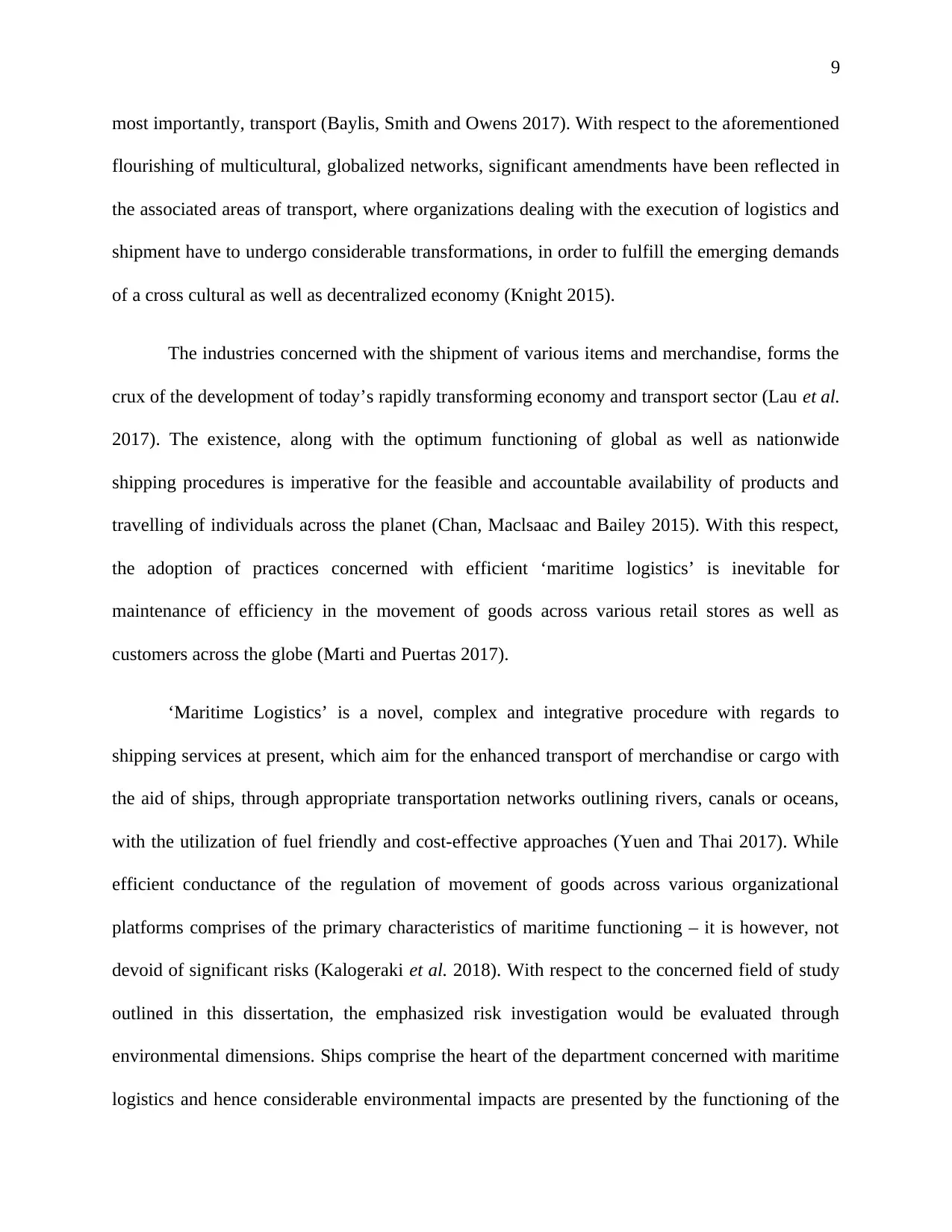
9
most importantly, transport (Baylis, Smith and Owens 2017). With respect to the aforementioned
flourishing of multicultural, globalized networks, significant amendments have been reflected in
the associated areas of transport, where organizations dealing with the execution of logistics and
shipment have to undergo considerable transformations, in order to fulfill the emerging demands
of a cross cultural as well as decentralized economy (Knight 2015).
The industries concerned with the shipment of various items and merchandise, forms the
crux of the development of today’s rapidly transforming economy and transport sector (Lau et al.
2017). The existence, along with the optimum functioning of global as well as nationwide
shipping procedures is imperative for the feasible and accountable availability of products and
travelling of individuals across the planet (Chan, Maclsaac and Bailey 2015). With this respect,
the adoption of practices concerned with efficient ‘maritime logistics’ is inevitable for
maintenance of efficiency in the movement of goods across various retail stores as well as
customers across the globe (Marti and Puertas 2017).
‘Maritime Logistics’ is a novel, complex and integrative procedure with regards to
shipping services at present, which aim for the enhanced transport of merchandise or cargo with
the aid of ships, through appropriate transportation networks outlining rivers, canals or oceans,
with the utilization of fuel friendly and cost-effective approaches (Yuen and Thai 2017). While
efficient conductance of the regulation of movement of goods across various organizational
platforms comprises of the primary characteristics of maritime functioning – it is however, not
devoid of significant risks (Kalogeraki et al. 2018). With respect to the concerned field of study
outlined in this dissertation, the emphasized risk investigation would be evaluated through
environmental dimensions. Ships comprise the heart of the department concerned with maritime
logistics and hence considerable environmental impacts are presented by the functioning of the
most importantly, transport (Baylis, Smith and Owens 2017). With respect to the aforementioned
flourishing of multicultural, globalized networks, significant amendments have been reflected in
the associated areas of transport, where organizations dealing with the execution of logistics and
shipment have to undergo considerable transformations, in order to fulfill the emerging demands
of a cross cultural as well as decentralized economy (Knight 2015).
The industries concerned with the shipment of various items and merchandise, forms the
crux of the development of today’s rapidly transforming economy and transport sector (Lau et al.
2017). The existence, along with the optimum functioning of global as well as nationwide
shipping procedures is imperative for the feasible and accountable availability of products and
travelling of individuals across the planet (Chan, Maclsaac and Bailey 2015). With this respect,
the adoption of practices concerned with efficient ‘maritime logistics’ is inevitable for
maintenance of efficiency in the movement of goods across various retail stores as well as
customers across the globe (Marti and Puertas 2017).
‘Maritime Logistics’ is a novel, complex and integrative procedure with regards to
shipping services at present, which aim for the enhanced transport of merchandise or cargo with
the aid of ships, through appropriate transportation networks outlining rivers, canals or oceans,
with the utilization of fuel friendly and cost-effective approaches (Yuen and Thai 2017). While
efficient conductance of the regulation of movement of goods across various organizational
platforms comprises of the primary characteristics of maritime functioning – it is however, not
devoid of significant risks (Kalogeraki et al. 2018). With respect to the concerned field of study
outlined in this dissertation, the emphasized risk investigation would be evaluated through
environmental dimensions. Ships comprise the heart of the department concerned with maritime
logistics and hence considerable environmental impacts are presented by the functioning of the
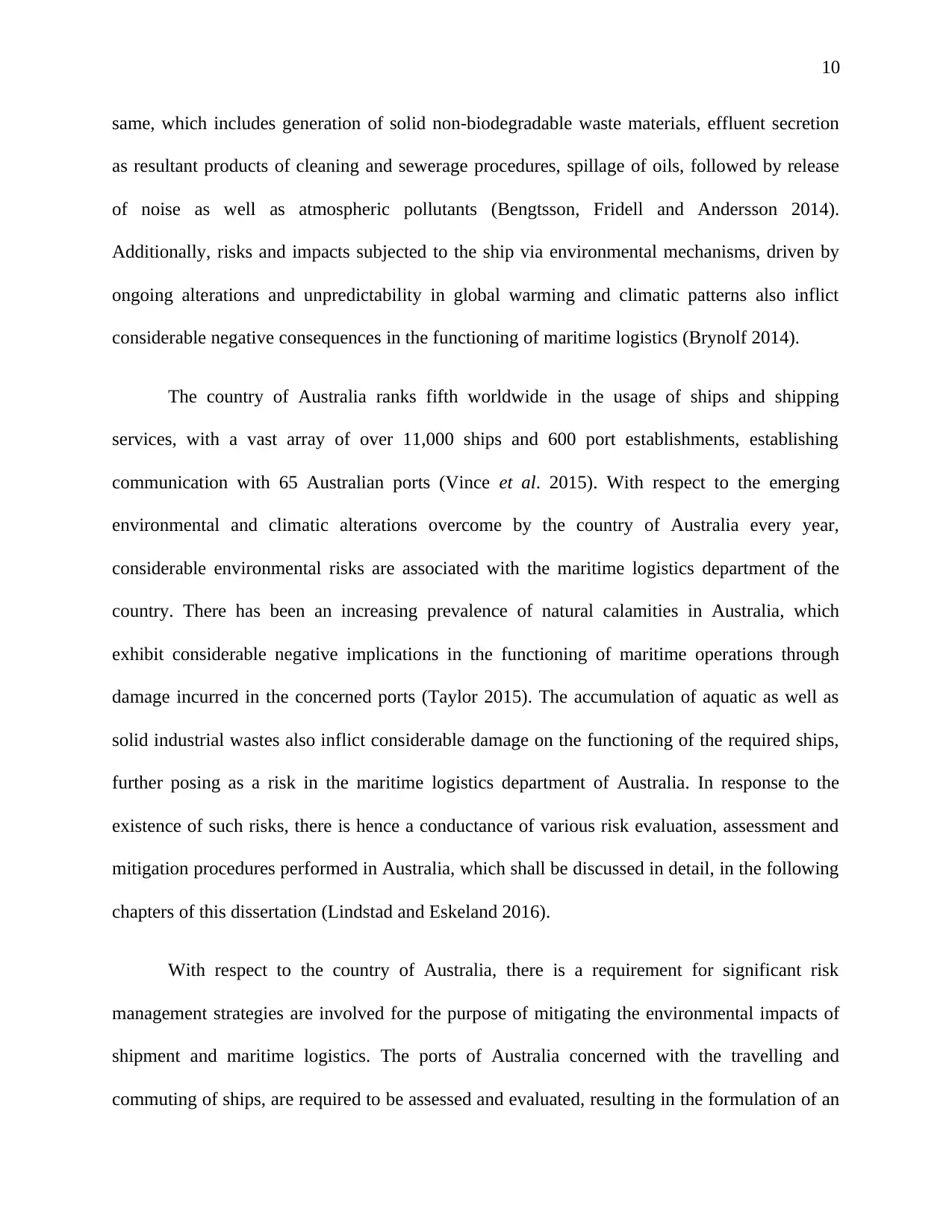
10
same, which includes generation of solid non-biodegradable waste materials, effluent secretion
as resultant products of cleaning and sewerage procedures, spillage of oils, followed by release
of noise as well as atmospheric pollutants (Bengtsson, Fridell and Andersson 2014).
Additionally, risks and impacts subjected to the ship via environmental mechanisms, driven by
ongoing alterations and unpredictability in global warming and climatic patterns also inflict
considerable negative consequences in the functioning of maritime logistics (Brynolf 2014).
The country of Australia ranks fifth worldwide in the usage of ships and shipping
services, with a vast array of over 11,000 ships and 600 port establishments, establishing
communication with 65 Australian ports (Vince et al. 2015). With respect to the emerging
environmental and climatic alterations overcome by the country of Australia every year,
considerable environmental risks are associated with the maritime logistics department of the
country. There has been an increasing prevalence of natural calamities in Australia, which
exhibit considerable negative implications in the functioning of maritime operations through
damage incurred in the concerned ports (Taylor 2015). The accumulation of aquatic as well as
solid industrial wastes also inflict considerable damage on the functioning of the required ships,
further posing as a risk in the maritime logistics department of Australia. In response to the
existence of such risks, there is hence a conductance of various risk evaluation, assessment and
mitigation procedures performed in Australia, which shall be discussed in detail, in the following
chapters of this dissertation (Lindstad and Eskeland 2016).
With respect to the country of Australia, there is a requirement for significant risk
management strategies are involved for the purpose of mitigating the environmental impacts of
shipment and maritime logistics. The ports of Australia concerned with the travelling and
commuting of ships, are required to be assessed and evaluated, resulting in the formulation of an
same, which includes generation of solid non-biodegradable waste materials, effluent secretion
as resultant products of cleaning and sewerage procedures, spillage of oils, followed by release
of noise as well as atmospheric pollutants (Bengtsson, Fridell and Andersson 2014).
Additionally, risks and impacts subjected to the ship via environmental mechanisms, driven by
ongoing alterations and unpredictability in global warming and climatic patterns also inflict
considerable negative consequences in the functioning of maritime logistics (Brynolf 2014).
The country of Australia ranks fifth worldwide in the usage of ships and shipping
services, with a vast array of over 11,000 ships and 600 port establishments, establishing
communication with 65 Australian ports (Vince et al. 2015). With respect to the emerging
environmental and climatic alterations overcome by the country of Australia every year,
considerable environmental risks are associated with the maritime logistics department of the
country. There has been an increasing prevalence of natural calamities in Australia, which
exhibit considerable negative implications in the functioning of maritime operations through
damage incurred in the concerned ports (Taylor 2015). The accumulation of aquatic as well as
solid industrial wastes also inflict considerable damage on the functioning of the required ships,
further posing as a risk in the maritime logistics department of Australia. In response to the
existence of such risks, there is hence a conductance of various risk evaluation, assessment and
mitigation procedures performed in Australia, which shall be discussed in detail, in the following
chapters of this dissertation (Lindstad and Eskeland 2016).
With respect to the country of Australia, there is a requirement for significant risk
management strategies are involved for the purpose of mitigating the environmental impacts of
shipment and maritime logistics. The ports of Australia concerned with the travelling and
commuting of ships, are required to be assessed and evaluated, resulting in the formulation of an
⊘ This is a preview!⊘
Do you want full access?
Subscribe today to unlock all pages.

Trusted by 1+ million students worldwide
1 out of 113
Related Documents
Your All-in-One AI-Powered Toolkit for Academic Success.
+13062052269
info@desklib.com
Available 24*7 on WhatsApp / Email
![[object Object]](/_next/static/media/star-bottom.7253800d.svg)
Unlock your academic potential
Copyright © 2020–2025 A2Z Services. All Rights Reserved. Developed and managed by ZUCOL.




